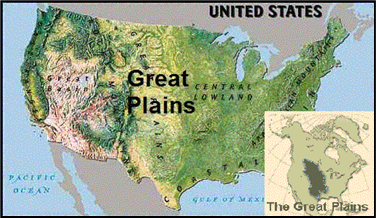


xxxxxAs we have seen, Custer’s famous “last stand” took place in June 1876 (Vb) at the Battle of Little Bighorn. The Sioux and other tribes had come out of their reservations in 1875 to protest against the horde of miners and prospectors entering the Black Hills, land which was sacred to them and had been granted to them by the government. But their victory over the U.S. Cavalry was short lived. Troops poured into the area. Many Sioux were killed, and the Black Hills were opened to white settlement. The final end to Sioux resistance came in 1890 with the coming of their Ghost Dance movement -
THE BATTLE OF WOUNDED KNEE 1890 (Vc)
Acknowledgements
Ghost Dance: live sketch by the American artist Frederic Remington (1861-
+Architecture. Map (North America): considered to be in the public domain – User:Dystopos – https:commons.wikimedia.org/wiki/File:Map. Map (Great Plains): licensed under Creative Commons – travel.wikihistoria.wikispaces.com/Wounded+Knee.
xxxxxAs we have seen, the Battle of Little Bighorn in June 1876 (Vb) -
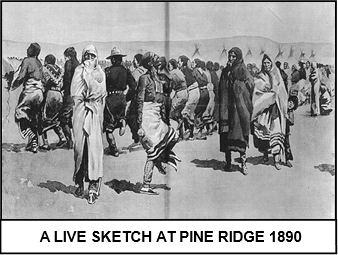
xxxxxThe final end to Sioux resistance came in 1890. It was then that the Ghost Dance movement -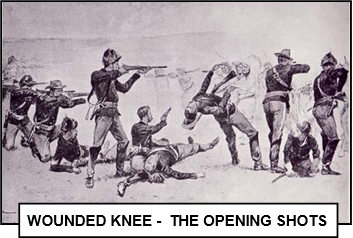 chief Big Foot, left the reservation, but at the end of the month, near Wounded Knee Creek, it was forced to surrender to the 7th U.S. Cavalry. The next morning, however when -
chief Big Foot, left the reservation, but at the end of the month, near Wounded Knee Creek, it was forced to surrender to the 7th U.S. Cavalry. The next morning, however when -
xxxxxThe so-
Vc-
Including:
The Indian Wars

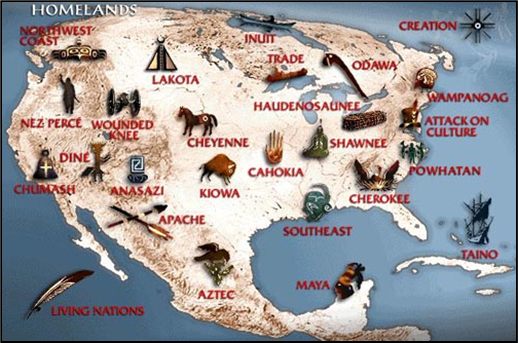 xxxxxThe Battle of Wounded Knee in December 1890 marked the end of 350 years of Indian Wars, a series of conflicts which began with the European exploration of North America in the mid 16th century, intensified through two hundred years of colonisation and colonial warfare, and came to an end after decades of bitter struggle against a U.S. government committed to westward expansion. By the end of the 19th century the indigenous peoples of North America, estimated at 10 million when the European settlers first arrived, had slumped to 237,000 in number and, territorially, were confined to cramped “reservations” -
xxxxxThe Battle of Wounded Knee in December 1890 marked the end of 350 years of Indian Wars, a series of conflicts which began with the European exploration of North America in the mid 16th century, intensified through two hundred years of colonisation and colonial warfare, and came to an end after decades of bitter struggle against a U.S. government committed to westward expansion. By the end of the 19th century the indigenous peoples of North America, estimated at 10 million when the European settlers first arrived, had slumped to 237,000 in number and, territorially, were confined to cramped “reservations” -
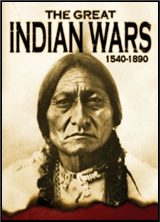 xxxxxThe battle as to who should control the vast area of North America began way back in 1540 when the Spanish adventurer Francisco Coronado explored the American South-
xxxxxThe battle as to who should control the vast area of North America began way back in 1540 when the Spanish adventurer Francisco Coronado explored the American South-
xxxxxThe arrival of the white settlers was soon opposed by the native Indians. Motivated almost entirely by the search for riches and the wholesale acquisition of land -
xxxxxIn North America, however, Indian resistance was stronger and more widespread, despite the strength of the opposition. In Virginia and southern Maryland, for example, relatives of the Indian chief Powhatan (father of Pocahontas) waged intermittent war against the English settlers from 1622 to 1644, and Pontiac’s Rebellion in the early 1760s, having laid siege to Detroit and won the Battle of Bloody Run, came close to driving the British out of the region around the Great Lakes.
xxxxxFurthermore, the situation in North America was complicated by colonial rivalry, particularly that between the British and the French. Here, as in King William’s War of 1689 to 1697 and King George’s War of 1744 to 1748, the American Indians took sides -
xxxxxWith the successful completion of the American War of Independence in 1783, the U.S. government tried, like the British before them, to come to terms with the American Indians. In its Act of August 7th 1789 it pledged that Indian lands and property would not be taken without their consent and that their rights and liberties were safeguarde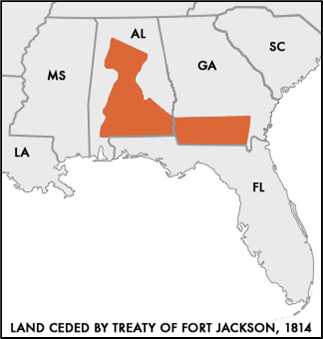 d by law. Nevertheless, settlers continued to push westwards, encouraged by the government, and this made conflict inevitable. In the early 1790s, for example, the Shawnee, Miami and other tribes swarmed across Indiana, Ohio and western Pennsylvania, and launched a series of successful attacks upon U.S. troops before being crushed at the Battle of Fallen Timbers in 1794. Later, an alliance of tribes, forged by the Shawnee chief Tecumseh, was only narrowly defeated at the Battle of Tippecanoe, Indiana, in 1811. In the south, the Creek War, waged from 1811 to 1814, ended in the Battle of Horseshoe Bend in Alabama, a fight in which 800 Indians were killed. By the Treaty of Fort Jackson the Creek Nation ceded 23 million acres to the U.S. government -
d by law. Nevertheless, settlers continued to push westwards, encouraged by the government, and this made conflict inevitable. In the early 1790s, for example, the Shawnee, Miami and other tribes swarmed across Indiana, Ohio and western Pennsylvania, and launched a series of successful attacks upon U.S. troops before being crushed at the Battle of Fallen Timbers in 1794. Later, an alliance of tribes, forged by the Shawnee chief Tecumseh, was only narrowly defeated at the Battle of Tippecanoe, Indiana, in 1811. In the south, the Creek War, waged from 1811 to 1814, ended in the Battle of Horseshoe Bend in Alabama, a fight in which 800 Indians were killed. By the Treaty of Fort Jackson the Creek Nation ceded 23 million acres to the U.S. government -
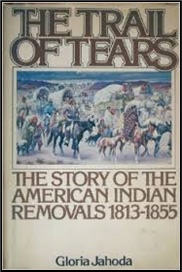 xxxxxHowever, by 1815 a strong movement had emerged in favour of settling all Indians further west, beyond the Mississippi River, so as to clear the way for white settlement. By the Removal Act of 1830 (intended to be implemented by negotiation) a number of tribes were coerced into moving to designated areas -
xxxxxHowever, by 1815 a strong movement had emerged in favour of settling all Indians further west, beyond the Mississippi River, so as to clear the way for white settlement. By the Removal Act of 1830 (intended to be implemented by negotiation) a number of tribes were coerced into moving to designated areas -
 xxxxxNor was this the end of the Indians’ forced migration. By the late 1840s some territory to which they had been driven, forcibly or otherwise, turned out to be rich in gold, and these lands and the overland routes to them were summarily taken over by the government. Thousands of wagon trains trundled westward, followed by the opening of the transcontinental railroad in 1869, an undertaking which took additional swathes of land away from the Indians. This encroachment on their final settlements, together with the wholesale slaughtering of the wildlife upon which their existence depended, led to some of the fiercest fighting of the Indian Wars. The thirty years from 1850 onwards saw the outbreak of raids and pitched battles across the plains, mountains and deserts of the American West beyond the Mississippi.
xxxxxNor was this the end of the Indians’ forced migration. By the late 1840s some territory to which they had been driven, forcibly or otherwise, turned out to be rich in gold, and these lands and the overland routes to them were summarily taken over by the government. Thousands of wagon trains trundled westward, followed by the opening of the transcontinental railroad in 1869, an undertaking which took additional swathes of land away from the Indians. This encroachment on their final settlements, together with the wholesale slaughtering of the wildlife upon which their existence depended, led to some of the fiercest fighting of the Indian Wars. The thirty years from 1850 onwards saw the outbreak of raids and pitched battles across the plains, mountains and deserts of the American West beyond the Mississippi.
xxxxxIn the Pacific Northwest, for example, there were three major conflicts during the 1850s -
xxxxxThe tribes of the Great Plains fought doggedly to preserve their territory, but were faced with the arrival of vast numbers of white immigrants and constant attacks upon their villages. This and the destruction of the buffalo, their main source of food, finally forced them to surrender. In the south, fighting in Colorado was marked by two savage atrocities in 1864, the 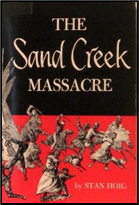 Hungate Massacre of a family of settlers, followed by the Sand Creek Massacre in which a hundred Indians were slaughtered. In Texas, the Red River War, a series of engagements in 1874-
Hungate Massacre of a family of settlers, followed by the Sand Creek Massacre in which a hundred Indians were slaughtered. In Texas, the Red River War, a series of engagements in 1874-
xxxxxAnd it was during this period of heightened conflict that in March 1871 the U.S. government decided to abandon any further negotiation with the Indian tribes, and to cease payment of any money for the compensation of lost land. It decreed that no Indian nation was to be recognised as “an independent power” within U.S. territory. The new nation had taken over the old.
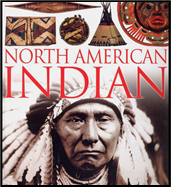
xxxxxIncidentally, the name “Indian” was first applied to the indigenous people of America by the explorer Christopher Columbus, assuming as he did that the mainland and islands of America were part of the Indies in Asia. The mistake was soon recognised, but the name stuck. In order to avoid confusion the term “Native American” was employed for many years, but this can apply to anyone born on the continent of America. Today the name American Indian is generally used. …...
xxxxx…… The Black Hills of Dakota, which had been given over to the Sioux by the Fort Laramie Treaty of 1868, and taken away from them by force eight years later, were found to be rich not only in gold, but also coal, oil, natural gas and uranium. In 1980 the Sioux were awarded $160 million by way of compensation.
xxxxxAs we have seen, the Battle of Wounded Knee in 1890 brought an end to the Indian Wars, that long period of intermittent fighting in which the American Indians fought against colonisation, took part in the colonial wars, and were eventually driven westward, forced to live in “reservations” far from their traditional homelands. In these wars the Indians were at a disadvantage. They fought with inferior weapons, they relied upon the wildlife for survival, and they succumbed in large numbers to the diseases brought to the continent by the Europeans, such as smallpox and typhus. At the end of the colonial wars the British government attempted to safeguard the Indians’ rights to land, as did the American government when it came to power in 1783, but the vast number of settlers looking for land and, later, gold in the West, proved unstoppable. The Indians were slowly driven westward, sometimes by coercion, sometimes by force, as in the Trail of Tears in 1838 (Va). By the end of the century, after a series of bloody battles across the American West, the Indians had been subdued and confined to their designated tribal areas.



